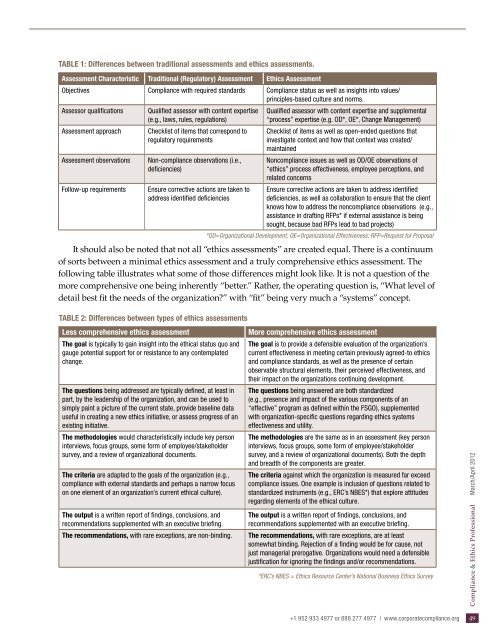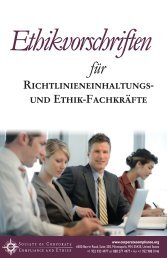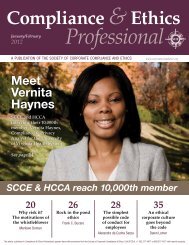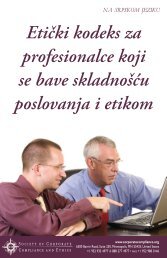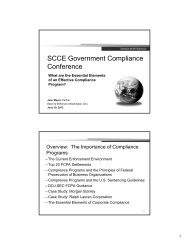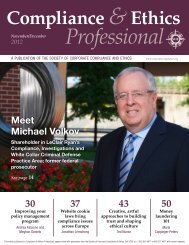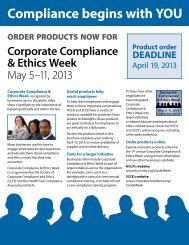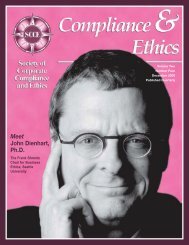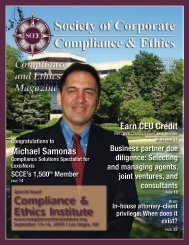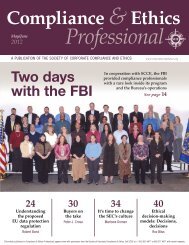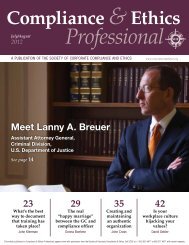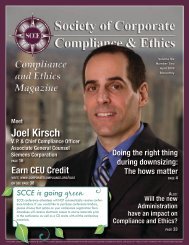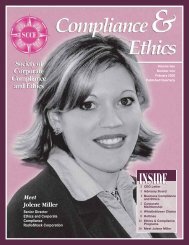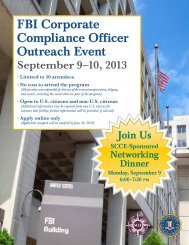Compliance & Ethics Professional - Society of Corporate ...
Compliance & Ethics Professional - Society of Corporate ...
Compliance & Ethics Professional - Society of Corporate ...
- No tags were found...
Create successful ePaper yourself
Turn your PDF publications into a flip-book with our unique Google optimized e-Paper software.
Table 1: Differences between traditional assessments and ethics assessments.Assessment Characteristic Traditional (Regulatory) Assessment <strong>Ethics</strong> AssessmentObjectives <strong>Compliance</strong> with required standards <strong>Compliance</strong> status as well as insights into values/principles‐based culture and norms.Assessor qualifications Qualified assessor with content expertise(e.g., laws, rules, regulations)Qualified assessor with content expertise and supplemental“process” expertise (e.g. OD*, OE*, Change Management)Assessment approachAssessment observationsFollow-up requirementsChecklist <strong>of</strong> items that correspond toregulatory requirementsNon-compliance observations (i.e.,deficiencies)Ensure corrective actions are taken toaddress identified deficienciesChecklist <strong>of</strong> items as well as open-ended questions thatinvestigate context and how that context was created/maintainedNoncompliance issues as well as OD/OE observations <strong>of</strong>“ethics” process effectiveness, employee perceptions, andrelated concernsEnsure corrective actions are taken to address identifieddeficiencies, as well as collaboration to ensure that the clientknows how to address the noncompliance observations (e.g.,assistance in drafting RFPs* if external assistance is beingsought, because bad RFPs lead to bad projects)*OD=Organizational Development; OE=Organizational Effectiveness; RFP=Request for ProposalIt should also be noted that not all “ethics assessments” are created equal. There is a continuum<strong>of</strong> sorts between a minimal ethics assessment and a truly comprehensive ethics assessment. Thefollowing table illustrates what some <strong>of</strong> those differences might look like. It is not a question <strong>of</strong> themore comprehensive one being inherently “better.” Rather, the operating question is, “What level <strong>of</strong>detail best fit the needs <strong>of</strong> the organization?” with “fit” being very much a “systems” concept.Table 2: Differences between types <strong>of</strong> ethics assessmentsLess comprehensive ethics assessmentThe goal is typically to gain insight into the ethical status quo andgauge potential support for or resistance to any contemplatedchange.The questions being addressed are typically defined, at least inpart, by the leadership <strong>of</strong> the organization, and can be used tosimply paint a picture <strong>of</strong> the current state, provide baseline datauseful in creating a new ethics initiative, or assess progress <strong>of</strong> anexisting initiative.The methodologies would characteristically include key personinterviews, focus groups, some form <strong>of</strong> employee/stakeholdersurvey, and a review <strong>of</strong> organizational documents.The criteria are adapted to the goals <strong>of</strong> the organization (e.g.,compliance with external standards and perhaps a narrow focuson one element <strong>of</strong> an organization’s current ethical culture).The output is a written report <strong>of</strong> findings, conclusions, andrecommendations supplemented with an executive briefing.The recommendations, with rare exceptions, are non-binding.More comprehensive ethics assessmentThe goal is to provide a defensible evaluation <strong>of</strong> the organization’scurrent effectiveness in meeting certain previously agreed-to ethicsand compliance standards, as well as the presence <strong>of</strong> certainobservable structural elements, their perceived effectiveness, andtheir impact on the organizations continuing development.The questions being answered are both standardized(e.g., presence and impact <strong>of</strong> the various components <strong>of</strong> an“effective” program as defined within the FSGO), supplementedwith organization-specific questions regarding ethics systemseffectiveness and utility.The methodologies are the same as in an assessment (key personinterviews, focus groups, some form <strong>of</strong> employee/stakeholdersurvey, and a review <strong>of</strong> organizational documents). Both the depthand breadth <strong>of</strong> the components are greater.The criteria against which the organization is measured far exceedcompliance issues. One example is inclusion <strong>of</strong> questions related tostandardized instruments (e.g., ERC’s NBES*) that explore attitudesregarding elements <strong>of</strong> the ethical culture.The output is a written report <strong>of</strong> findings, conclusions, andrecommendations supplemented with an executive briefing.The recommendations, with rare exceptions, are at leastsomewhat binding. Rejection <strong>of</strong> a finding would be for cause, notjust managerial prerogative. Organizations would need a defensiblejustification for ignoring the findings and/or recommendations.*ERC’s NBES = <strong>Ethics</strong> Resource Center’s National Business <strong>Ethics</strong> Survey<strong>Compliance</strong> & <strong>Ethics</strong> <strong>Pr<strong>of</strong>essional</strong> March/April 2012+1 952 933 4977 or 888 277 4977 | www.corporatecompliance.org 49


